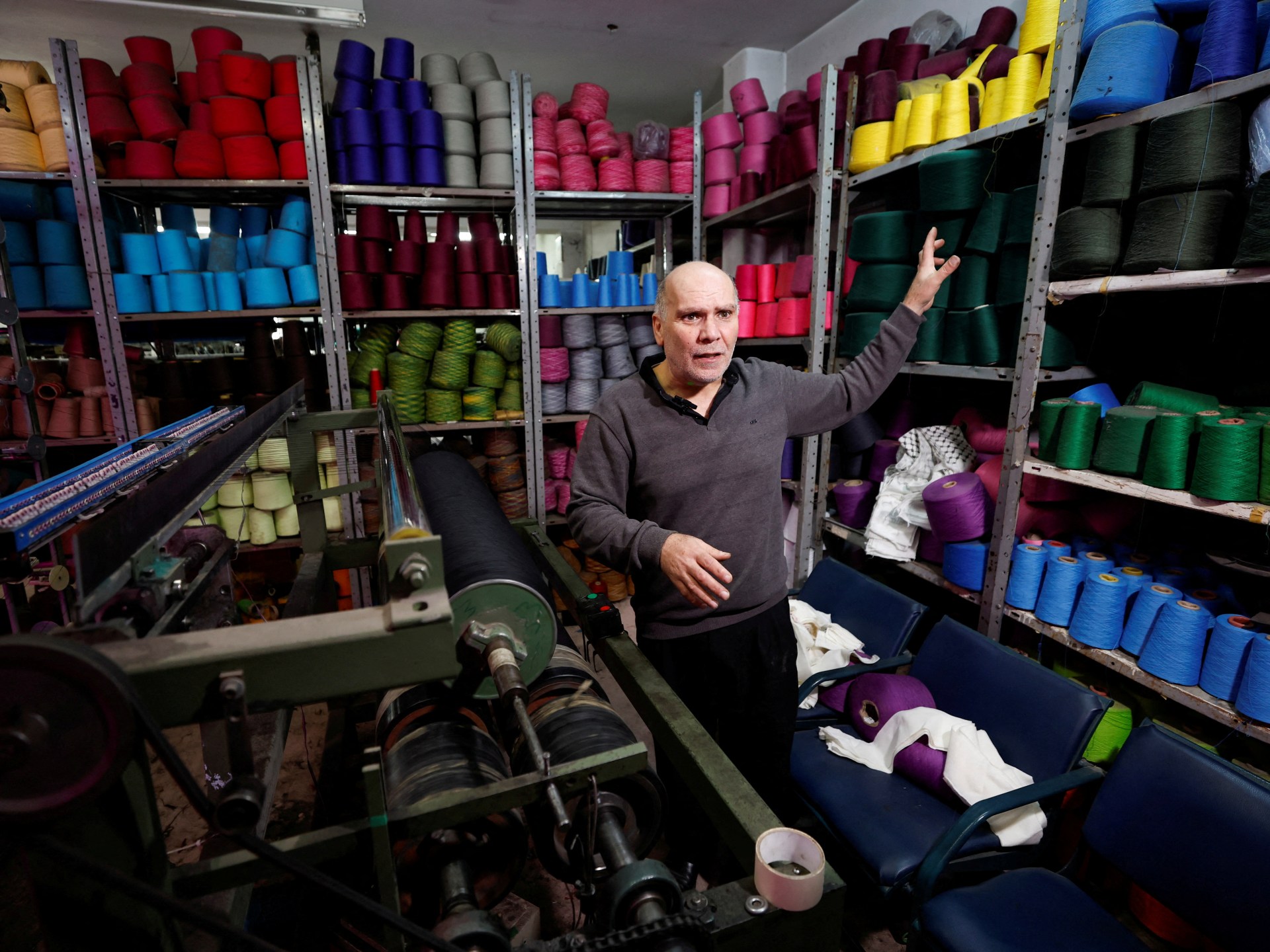The dark underbelly of Pakistan’s male body image revolution | Arts and Culture
Karachi, Pakistan – In a small room in his modest family home, Asad Naqib Khan threads a sewing machine needle.
As the rhythmic hum of the machine fills the air, the tailor’s gaze occasionally drifts over to the screen of his mobile phone in the hand of his oldest child. The father and son are watching bodybuilding videos on YouTube.
Twenty-eight-year-old Asad is a father of five children aged 10 and younger. He is not just a tailor struggling to make ends meet — he is also an aspiring bodybuilder.
“For as long as I can remember, I have wanted to become a bodybuilder,” he explains while hemming a shirt that morning in early 2022. “I used to watch older guys in my neighbourhood go to the gym and spend time building their strength and muscles.” As a teenager, he fantasised about doing the same. “Once, I went to watch a bodybuilding competition and wanted to become just like the men I saw on the stage,” he recalls.
Asad grew up with eight siblings and remembers how his father, a daily wage labourer, would struggle to find regular work to support his family. As the eldest son, Asad felt compelled to share his father’s financial responsibilities as soon as he became a teenager. Leaving middle school meant he had limited options, but instead of opting to become a labourer like most men from his neighbourhood, he decided to apprentice with a tailor. When he was 18, he branched out on his own. Over the years, however, he yearned for the one thing he believed would bring purpose and happiness to his life – to become a professional bodybuilder. “One of my biggest dreams is to make Pakistan proud by competing internationally and winning for the country,” he explains.
But it wasn’t until 2019, when he met Zahir Shah, a former bodybuilding champion in his 40s who owns a gym in a busy Karachi neighbourhood, that Asad began on this path.
Asad finishes sewing the shirt and hands it to his son to fold. He says that his children, particularly the two boys, take delight in watching his workout videos. “They urge me to work out harder so I win first place. God willing, I will make them proud.”
He envisions introducing his sons to bodybuilding, and also has aspirations to open his own gym, like Zahir, which his boys can one day help him run “so I don’t have to work as a tailor any more.”
A hidden world
The world of Pakistani bodybuilding is one that few outsiders ever get to see.
With no state funding, national structure, or regulation, the sport thrives in the shadows, haphazardly managed by about a dozen independent federations scattered across the country.
The growing global interest in fitness and bodybuilding culture has fuelled local interest in the sport with a surge in Pakistanis flocking to their local neighbourhood gyms.
Young men train tirelessly to showcase their physiques for competition judging panels through a series of poses to highlight muscle definition, size and symmetry.
Since Pakistan’s first championship was held in 1952, bodybuilding has remained largely a working-class pursuit – it is often referred to as a “poor man’s sport” within the community – and confined to small-scale regional and national competitions. But the sport has undergone a profound transformation in recent years owing to international exposure through social media, gaining wider attention and affording its star bodybuilders unprecedented opportunities. The prospect of participating in international championships, fame, cash prizes, travel, and potential modelling contracts has attracted thousands of men from Karachi to Peshawar and beyond. Aspiring bodybuilders with limited means spend their evenings after school or work fervently lifting weights beneath the glare of fluorescent gym lights and their coaches’ watchful eyes.
Many see bodybuilding as the first step out of poverty and dead-end jobs. Some are drawn to the allure of social media stardom as they post photos of their chiselled bodies online, while others dream of breaking into the modelling industry. Through interviews with bodybuilders and other industry insiders over reporting carried out between September 2021 and January 2024, we learn how men navigating the intersection of bodybuilding and modelling are exposed to worlds that both celebrate, and exploit, physical appearance.
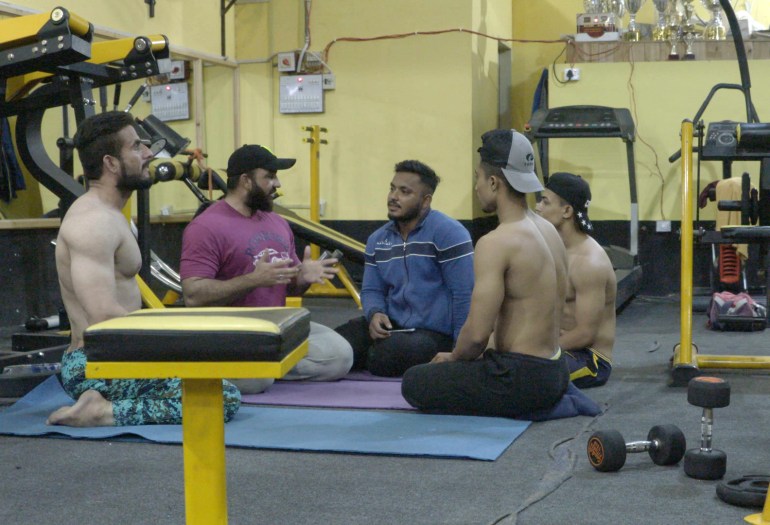
The cost of bodybuilding
It is almost midnight, and the abandoned streets of a quiet residential colony lined with weathered concrete homes are lit with the dim glow of flickering streetlights. On the second floor of a small building, the lights of Zahir’s gym still burn brightly. Despite the late hour, the gym is packed and buzzing with energy, and old Bollywood songs blare from the speakers at each end of the stuffy room. Asad, and about two dozen other young men, are busy lifting weights. Their dedication to their training, according to Zahir, is often driven by the urge to conform to the archetypical male beauty standard set by global celebrities and influencers.
“Having big muscles has become a status of attractiveness because of what we see in movies from Hollywood and Bollywood … and these young boys also want to look like that,” he explains. “For most of these boys, looking good is far more important than just being healthy.”
For many, it is a costly pursuit.
“Building a body that stands out costs more than most of these men earn,” Zahir explains.
The average monthly salary in Pakistan in 2023 was 81,925 rupees ($291) and most men entering the sport – either new graduates or unskilled workers – make significantly less. Balancing the responsibility of supporting their families amid Pakistan’s economic crisis with the financial demands of bodybuilding such as gym memberships, specialised diets, protein supplements, and professional coaching, is a huge challenge. Many bodybuilders end up borrowing money from friends or family, or taking out loans. Some become completely dependent on their coaches for support.
“I’ve been working as a tailor for over a decade, earning around 30,000 rupees ($107) per month,” says Asad, pausing after a set of bench presses. “Affording the essential protein-rich diet, which costs at least 1,000 rupees ($3.50) daily, is beyond my means.”
In fact, his entry into bodybuilding only became possible because Zahir waived his initial gym fees, offered complimentary training sessions, and occasionally assisted with his diet.
On the packed floor of his gym, Zahir watches the movements of his clients. “When Asad came to me he was like a matchstick,” he recalls fondly. “He is a very hard worker and one of my best students.”
Asad, who relies solely on the income generated from sewing shalwar-kameez, finds himself grappling with numerous financial responsibilities. It is a constant struggle to cover the children’s school fees, pay for nutritious food and meet other household costs. Even so, six or seven nights a week he rides his old bike across town to Zahir’s gym to spend the evening lifting weights.
“The coach helps me with whatever he can. I have even borrowed money from friends just so I can buy chicken and fish,” he admits, wiping sweat off his forehead as he gets ready for another set of repetitions.
“All the difficulties we face in reaching our goal are brought to fruition when we go out in public and people turn their heads to look at us,” another of Zahir’s trainees chimes in.
Zahir, who is a strong advocate for natural bodybuilding – training without the use of steroids, growth hormones, or diuretics – plays a pivotal role in Asad’s bodybuilding journey as he helps him prepare for competitions and foster discipline.
Asad confidently struts across the floor bare-chested, joking and engaging with others. “Even when I’m sewing clothes, my heart is here, in the gym,” he says with a big smile.
He is in no rush to go home, and says he will stay until 1 or 2am. It’s the kind of sport, he explains, where “the bigger you get, the smaller you feel you are, so you want to work harder to become even bigger.”
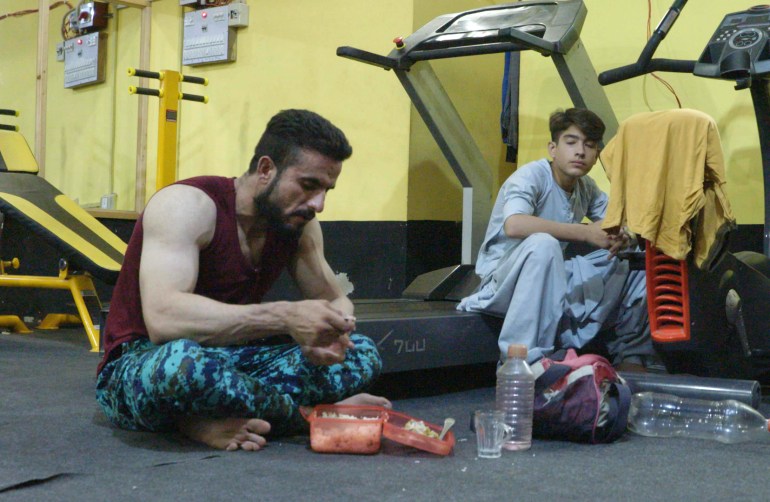
Gaining confidence
Across town, Usama Saeed, 30, a former bodybuilder who works as a fitness trainer at several gyms, wolfs down a homemade lunch of boiled rice and chicken inside a newly renovated air-conditioned Karachi gym. It’s almost 2pm, and his clients will soon start arriving for their daily training sessions.
Usama is well-built. He wears a snug white tank top, a silver chain glints against his skin and his gelled hair has new highlights. There is an authority in the way he effortlessly moves about the room, but, running a hand through his hair, he shyly admits that he has not always been this way.
He embarked on his bodybuilding journey after spending much of his teenage years in hospital receiving treatment for sarcoma, a rare bone and soft tissue cancer. “The cancer had left me physically frail, weighing a mere 42 kilos [93 pounds],” he explains, and that made him an easy target for bullying. “My own friends and cousins used to make fun of me because of my appearance.”
Usama recalls how they would incessantly poke fun at his scrawny build, suggesting that no girl could ever be interested in him and how he “would go flying in the air if they so much as blew air on me … that’s hurtful for any young man.” Usama, who was 21 at the time and still recovering from his disease, says he withdrew into a shell and became a complete recluse. “I had zero body confidence and couldn’t face people … That’s when my best friend encouraged me to go to the gym with him.”
The gym gradually became Usama’s sanctuary and it was there that he first encountered bodybuilders. “Within a few months, as my body began to transform, I got it in my head to completely change the way I looked,” he recalls. Usama’s decision to begin training to become a professional bodybuilder soon after he went into remission met disapproval from his parents.
“My parents and siblings are all doctors. They were overprotective and concerned about my health, but like all middle-class Pakistani families, they also had trouble respecting my decision to pursue professional bodybuilding instead of becoming a doctor like them,” Usama explains. He still lived at home and relied on his family for living expenses, but they refused to pay for protein supplements, hoping to discourage him. “But I had made up my mind.”
Eventually, his family came around. “My mother began noticing the changes in me; how people would watch me in public and how I was getting my confidence back, she accepted it … My family is proud of me now, but I wish they had supported my decision early on,” he says.
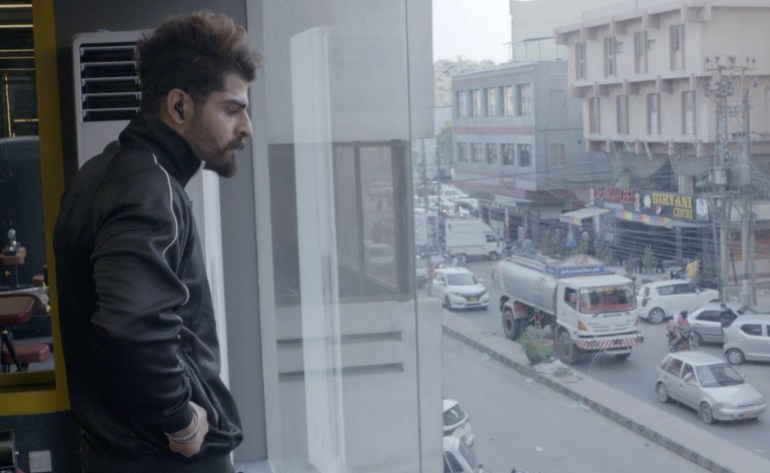
Drug shortcuts
Usama leans back on the elliptical trainer and sneaks a peak at himself in the full-length mirrors that line the gym wall. Although he has come a long way since the days spent in hospital, his fitness journey was fraught with substantial health risks that young bodybuilders often encounter in their quest for quick results.
“My first [competition] cycle was in 2018. I had zero knowledge about muscle growth and steroids, and did whatever my trainer told me. This included taking steroids because I was obsessed with getting my body ready for the stage,” Usama recalls.
“For months, I was pumped with growth hormones and 500 milligrams (0.018 ounces) of Trenbolone two or three times a week by my trainer whose only goal was to bulk me up so I would win. I had no idea how dangerous this was.”
Trenbolone, a potent anabolic steroid, is a class of synthetic drug originally developed to promote muscle growth in livestock. Anabolic steroids, as well as synthetic growth hormones, are commonly used by bodybuilders in Pakistan and can seem like a shortcut to building muscle although they may carry severe potential side effects and are banned by the WADA (World Anti-Doping Agency), the recognised anti-doping global authority.
Some anabolic steroids and growth hormones may be prescribed by doctors for medical reasons such as hormone replacement therapy or to treat muscle wasting associated with cancer, HIV/AIDS and other conditions. However the non-medical use of these drugs poses risks such as cardiovascular complications, liver and kidney damage, high blood pressure, and hormonal imbalances which can lead to issues ranging from acne to infertility and even long-term psychological dependency.
The potential for misuse, abuse, and associated health risks is the reason why it is illegal for pharmacies in Pakistan to sell steroids and hormones without a prescription.
Illicitly imported versions, however, are commonly available on the black market, Usama says.
To illustrate his point, he pulls out his mobile phone, dials a number and puts the call on speakerphone. After two rings a groggy male voice answers. Usama gives him a reference and asks him what “stuff” is available. Almost mechanically, the man begins listing drugs as if reading them off a menu.
“If you know where to look, it can be delivered to your doorstep within minutes,” Usama declares matter-of-factly.
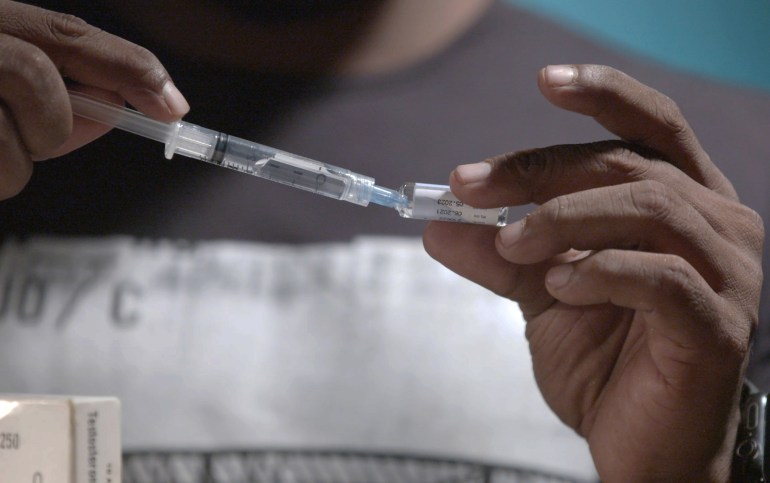
‘Not allowed to say “no” to your coach’
The risks associated with steroids and growth hormones rarely deter coaches, Usama says.
“Gyms are a breeding ground for drug abuse. It is more common than you could ever imagine,” he explains while driving through Karachi’s bustling rush hour traffic to another gym where he will spend the evening training another set of clients in a residential complex.
Gym owners and coaches are notorious for encouraging the use of substances among their most talented athletes and even paying for the drugs as these men effectively act as living advertisements for their establishments, Usama explains. “The larger and more muscular athletes become under their training, the greater the number of victories and titles their gym and coaches can lay claim to,” he says. This helps bring in more clients.
Zahir, who claims he has banned his athletes from taking any drugs and encourages them to focus on their diet and workout routines, agrees. He says he has witnessed coaches make their own capsules and distribute them to inexperienced athletes. “They are just in it to make a quick buck … they are playing with their lives,” he says, shaking his head with disapproval.
Over time, Usama explains from personal experience, young bodybuilders come to rely on their coaches for guidance on which steroids to take and in what quantity. Al Jazeera has witnessed coaches routinely inject obliging trainees with unregulated amounts of steroids.
“If bodybuilders need to be scared of anything, it is the influence of manipulative coaches who brainwash trainees so much, they begin taking steroids like regular painkillers or cough medicine,” says Usama, recalling how he was encouraged to pop pills and inject his body with a multitude of drugs he “can’t even remember the names of” while preparing for competitions.
And coaches, who typically demand respect and blind obedience, wield significant influence in the lives of young bodybuilders.
That is particularly true when the coach is your sponsor, Usama says.
“I was very happy when my coach offered me my first job as a trainer,” he recalls. The job barely paid anything, but the perks included free access to the gym, which was a huge incentive for him as a student, and a “‘full stack’ – which included all the steroids I would need for my competing cycles, fully paid for by the coach.” Usama rolls his eyes and chuckles wryly. “This is how they trap you,” he says.
“When they invest their money in you, they make you feel special,” he explains, “then they expect you to submit to them completely.”
Usama says he was made to work long hours by his coach who had little consideration for his health and wellbeing. He was never allowed to question the drugs he was made to take, and was also barred from competing for federations other than the ones his coach had affiliations with. “It’s very easy for them to get you banned, so you have to be careful … You are simply not allowed to say ‘no’ to your coach.”
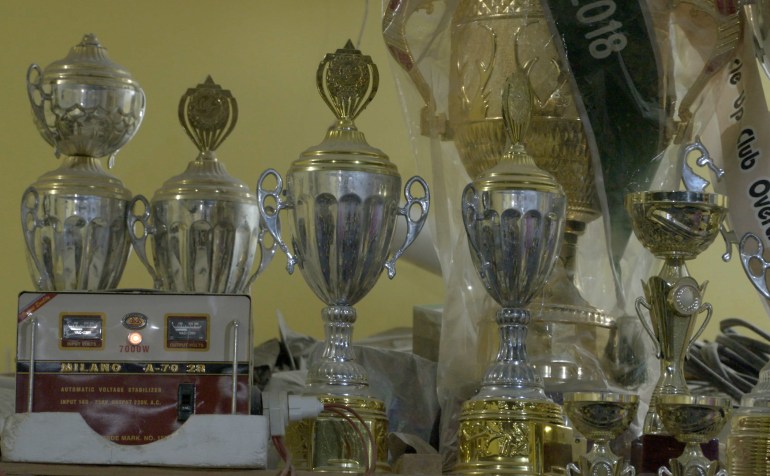
Dangerous practices
Usama says bodybuilding is “a very masculine sport” that demands subjecting one’s body to pain and risk in the pursuit of proving dominance over other men. “At the same time, it’s also very emasculating because you are always controlled by someone else … there’s no peace of mind,” he says.
In 2020, after two years of professional bodybuilding, Usama decided to stop competing so he could focus on his work as a trainer, and quit taking performance-enhancing drugs. He considers himself fortunate for stopping early. “I only suffered from headaches and mood swings,” he says. “But many bodybuilders continue taking these drugs for prolonged periods, and they end up suffering from serious side effects.”
In 2021, the sudden death of 51-year-old Shehzad Khan Afridi, a celebrated bodybuilder and former Mr Pakistan, the biggest national bodybuilding championship, just days after winning a gold medal in the 75kg (165-pound) category of a competition held in Karachi, drew attention to the potentially life-threatening abuse of substances taking place behind the closed doors of Pakistan’s gyms.
According to Sohail Anwar, secretary of the internationally recognised Pakistan Bodybuilding Federation (PBBF), founder of a popular gym chain, and former decorated bodybuilder in his 50s who has spent the last 20 years coaching bodybuilders competing internationally, “Afridi was supposed to compete in the 85kg [187-pound] category, but a couple of days before the competition he was moved to the 75kg category.”
Anwar, who was Afridi’s coach in 2011 when he first won that title, explains that losing 10kg (22 pounds) in two or three days requires deprivation of sodium, water, and injecting “yourself with dangerous amounts of diuretics”.
“Diuretics draw all the fluids out from your body and the dehydration thickens your blood which can … lead to heart failure,” he explains.
Afridi’s death was the most publicised in Pakistan in recent times, but it was not the only one.
In 2016, four professional Pakistani bodybuilders, two of them gold medallists in the South Asian Bodybuilding Championship, died due to alleged steroid abuse within a single month.
Despite the concerns, many coaches, including Anwar, admit it is difficult for professional bodybuilders to win contests without steroids.
Given that regional and local bodybuilding federations face a lack of clear governance and guidelines, anti-doping and safety-promoting efforts have been ad hoc. For now, the prevailing culture is one where athletes simply “have to take steroids so they stand a chance at winning,” Anwar says. “It would be foolish for anyone to go to a nuclear war with just a sword in their hand.”
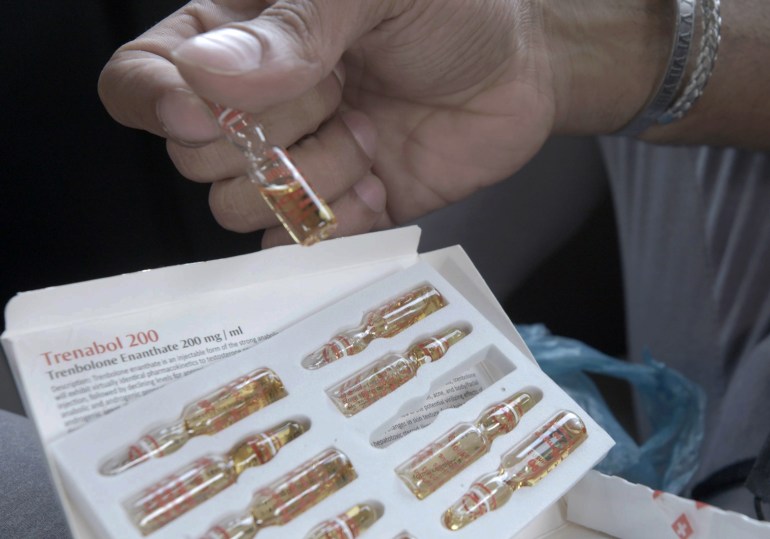
Aspiring models
On the residential outskirts of Islamabad, Kamran Safdar, who is in his 40s, welcomes Zishan Khan, 30, a seven-time bodybuilding champion and aspiring model, into his small, dimly lit home studio.
Kamran’s polite, unassuming demeanour defies his reputation in the area as a go-to photographer for more daring portfolios.
While societal norms traditionally encourage women to be more conservative in their self-expression, recent trends have granted Pakistani men greater online freedom. With more access to mobile phones and social media, men have pushed the boundaries of what was once considered socially acceptable through the proliferation of scantily clad photos and shirtless selfies posted to platforms like Instagram and TikTok.
This rapidly evolving digital ecosystem has spurred a new generation of bodybuilders and fitness influencers to gain online followers and recognition. Those with more serious job aspirations look to get professional portfolios made in hopes of gaining new followers but also securing paid modelling work.
A basic shoot that doesn’t require extensive production may cost approximately 5,000 rupees ($17.70), according to industry insiders. Most agree that the more suggestive a shoot, the higher one’s chances of getting noticed by talent scouts.
“Sometimes, clients will come with their own references and ask for a ‘bold’ shoot … you have to understand people’s limitations and requirements have both changed,” Kamran says.
Zishan, who is from the traditionally conservative province of Khyber Pakhtunkhwa, is also defying norms. He has taken the day off from his administrative government day job to travel two hours by public bus from the city of Mardan to Islamabad for the photoshoot, and has come to Kamran with a specific request: to look like a warrior in his new photos. Kamran pulls out a piece of faux fur, handmade leather cuffs, and a Viking helmet from a canvas bag for him to wear.
“My friends and family don’t approve when I take bold pictures in underwear,” Zishan declares amid the camera flashes. “But I’m not afraid of a backlash – I do what feels right to me.”
“I have spent thousands of rupees on my physique and I enjoy showing it off,” he says. “He makes my body look good,” Zishan adds, proudly showing previous pictures taken by Kamran saved on his phone.
Zishan’s portfolio hasn’t led to any significant jobs yet, but he is hopeful this will change.
The next morning, Kamran is photographing 25-year-old university student Hammad Khan who is also a professional bodybuilder with modelling aspirations.
They are at a secluded woodland spot next to Islamabad’s Rawal Lake.
“Showing [my] body off can be very empowering,” Hammad says. “When a lion suddenly jumps out of the bushes, he shocks and impresses everyone. I hope these photos will do the same for me. I am currently off-season so my body is not in great shape, but my existing followers are expecting new photos,” he explains excitedly as Kamran uses concealer and a makeup brush to cover his acne.
Hammad undresses and then runs into the water in his underwear to splash himself for the shoot.
“I could never do this in my hometown in Swabi,” he chuckles nervously. Swabi, located approximately 100 kilometres (62 miles) northwest of Islamabad, is a small municipal city in the Khyber Pakhtunkhwa province of Pakistan. “The people are much stricter and closed-minded there. It’s a cultural thing.”
He says his photos draw mixed reactions. “Some people compliment and call me sexy, but many also curse me,” says Hammad, before a quick wardrobe change behind a tree into snug neoprene pants for another round of photos.
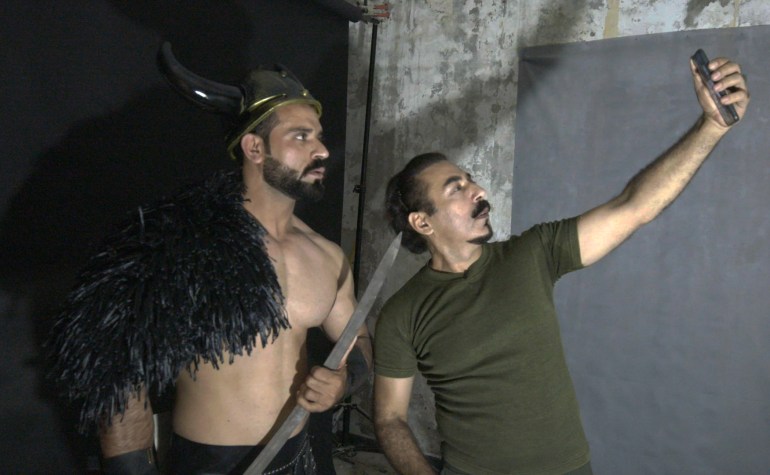
Exploitation and false promises
“There is an Urdu saying: ‘Dikhay ga to bekay ga [If it’s seen, it will be sold]’,” says Usama. “If I don’t look a certain way or don’t maintain how I look, nobody will come to me for training.”
As the day winds down and Usama’s last clients head out, his friend invites him back to the gym floor to snap photos and shoot workout videos for each other’s social media.
Usama raises a brow, pouts and lifts his shirt as his friend cheers him on while filming content for Usama’s Instagram and TikTok accounts where he has more than 18,000 followers on each platform. “This is my bread and butter now and I have to be more strategic in how I sell myself to the public,” he says, referring to how he relies on his social media profiles to draw in potential gym clients. Recently, he has also started receiving offers for paid endorsements to promote local fitness products.
“Every time I post ‘masala’ [spice], my engagement shoots up,” he adds. But whenever he uploads a new shirtless selfie, he is also inundated with private messages and photos.
“A lot of them are from women, but the majority are from men who only have sex on their mind,” he says, scrolling through a long list of unread messages. “I don’t engage with them but I still enjoy going through the messages because essentially they are a compliment.”
Many bodybuilders active on social media say their inboxes are often flooded with inappropriate comments from male followers, some pleading to meet or offering financial incentives in exchange for sexual favours.
This newfound attention can easily become a powerful addiction, according to veteran Karachi-based fashion and entertainment journalist Zurain Imam. With a career spanning 30 years, Imam has closely observed the journeys of individuals in industries that idealise physical beauty. “For most, it is all related to self-worth and seeking validation, wherever it comes from,” he says amid the clamour of blaring music and lively conversation at a rooftop party in late 2023. “[Some] might be posting to get attention from photographers and designers for modelling gigs,” he explains, adding that many young aspiring male models posting online have told him they have received unwarranted DMs and sexual propositions from industry professionals.
Hammad, Zishan, Usama, Asad, and Zahir, along with countless other bodybuilders from their community say exploitation is a reality for many trying to get into modelling. Each of them has experienced false promises of work or complimentary photoshoots only to find themselves in uncomfortable situations, harassed, or being offered work in return for sexual favours.
“You have to understand that false promises and exploitation of young men majorly outweighs them actually getting ongoing and respectfully earned work,” Imam elaborates.
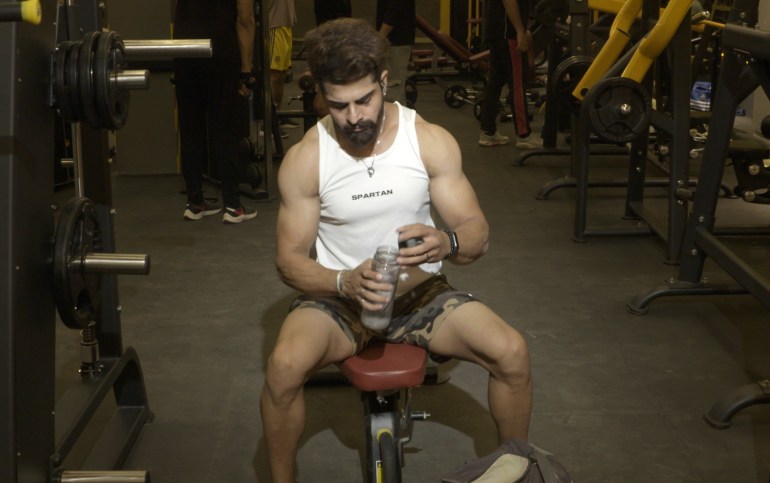
‘There is a predator at every corner’
A few years ago, after trying for a couple of years to gain a foothold in the fashion industry, Usama got a break when he was selected to walk the runway for a renowned fashion designer at a fashion week event. “It was a huge deal for me and I was very excited,” he reflects. “I had done all the fittings and on the night before the fashion show, I got a call from the designer asking me to visit him in his hotel room. He made it clear to me that if I went along, he would make me a star by hiring me for all his future shows and campaigns; that he would take care of me like a ‘sugar daddy’.”
He smiles but there is resentment in his voice – his dream was dashed that night. Usama refused, and his name was struck off the call sheet. The designer, who is married with grown children, mocked Usama’s decision. “He said hundreds of models enter the business every day who would be grateful for the opportunity,” he recalls.
“Without any exaggeration, there is a predator at every corner,” says Usama, who still receives inappropriate messages from other renowned fashion designers. “These are powerful people with verified profiles on social media,” he adds, showing screenshots of their conversations.
Many models from humble backgrounds who feel forced to capitulate are eventually “groomed to become the ‘property’ of those who promoted and supported them,” Imam says. “They never really get out from under the influence of their initial enablers.”
Hammad, who, like Zishan, says his interactions with Kamran have consistently been respectful, has received numerous offers for free photoshoots via social media from individuals claiming to be professional photographers. “The first time I got an offer for a free photoshoot, I was very excited,” he says, recalling an interaction shortly after he won his first bodybuilding title several years ago. “He told me he was an experienced photographer with an impressive portfolio, but straight away he asked to see my full nude photos.”
Recently, Zishan says a photographer invited him to his Islamabad studio with the promise of a potential modelling job. Midway through the shoot, the photographer groped him. “I just got up and left,” he recalls, angered and disappointed by the incident. “But a lot of immature and inexperienced guys get intimidated, and get involved in wrong things. People can do anything for money.”

The aftermath of a video leak
Haroon, a 28-year-old teacher from Karachi, started bodybuilding to pursue a modelling career that never materialised.
Sitting on a large rock at Karachi’s Clifton beach, Haroon, who requested that only his first name be used in this story, takes a deep breath and gazes blankly at the tranquil low tide. A procession of camels adorned with vibrant tassels and jingling bells crosses the shore.
“After being asked to take off my clothes and sleep with the casting directors and photographers on pretty much every audition that I ever went to, I was ready to give up,” Haroon recounts, fidgeting with his phone’s shattered screen.
Much like other young men hailing from lower middle-class families, Haroon says he grew up juggling personal aspirations and the responsibility of supporting his ageing parents and sister. The weight of these responsibilities took on a new urgency in 2020 when, at the height of the pandemic, he lost his job as a teacher. Broke and desperate to find work, one of his gym friends “proposed the idea of venturing into sex work,” he recalls. He agreed to go along as he needed cash and saw no other choice.
“One evening, he arranged for me to meet one of his contacts who apparently had the connections to get me some good clients,” Haroon explains. “When I got to the apartment, the man and two other guys said they would have to ‘audition’ me to assess the kind of clients they could refer to me,” he adds, looking up with a grimace. “At the time, I didn’t realise they were also filming the whole encounter.”
The following day, Haroon discovered that they had leaked the video online, revealing his face and name.
In a country where homosexuality is heavily persecuted and considered a criminal offence, and where there is a huge stigma attached to sexual abuse, the trauma and alienation that Haroon suffered in the aftermath was immense.
“Thankfully, my parents never found out, but friends and old colleagues did and they stopped talking to me completely … even my best friend, who I used to share everything with, completely boycotted me. We haven’t spoken since the incident,” he recalls. Haroon felt such shame that the idea of interacting with people prompted him to withdraw from the world. “But then I went through a phase where I didn’t care any more because the worst had already happened.”
Haroon admits he went on to create more video content that he now deeply regrets. He also endured intense bouts of depression that led to self-isolation and self-harm. “People think something like this would be hard on women but it’s hard for men, too,” he says.
Haroon explains the only way he has been able to cope and try to move on is by making a conscious effort to “not think about it” and concentrate on his future. “Ever since I was a kid, I wanted to be famous,” Haroon sighs. “I just never imagined it would be like this.”

‘Worth millions to me’
Many Pakistani bodybuilders believe the absence of support networks to address physical, emotional and professional strains leaves individuals vulnerable to abuse and isolation.
“Young men are alone when it comes to handling difficult situations in both modelling and bodybuilding,” says Imam. “It is up to them to protect themselves.”
Anwar of PBBF believes there is a simple solution to nurture more supportive environments within gyms. The government of Pakistan must identify one internationally recognised bodybuilding federation, he says, and give them the authority to only allow gyms that work with trainers who fulfil certain safety standards to participate in bodybuilding championships.
This, he argues, could raise awareness about the risks associated with using harmful substances, while advocating for natural bodybuilding, the approach Zahir promotes.
Meanwhile, Asad, Zahir’s athlete, the tailor, continues to compete in regional contests. Competition days are a whirlwind of activity as coaches deftly and hurriedly apply tanning lotion to accentuate their protégés’ muscles before contestants are summoned to the stage to pose for the judges.
Back in November 2021, when he was declared the new Junior Mr Sindh at a competition just outside of Karachi, Asad beamed as he strutted onstage to collect his large golden trophy.
“It’s plastic but it’s worth millions to me,” he’d declared as supporters thronged him, eager to snap selfies.
But for now, his financial situation continues to be difficult, prompting him to take a second part-time job sewing garments at a factory near his home. He is currently on a break from training to save money for diet and coaching fees so he can realise his dream of competing for the Mr Pakistan title. “It is taking time, but I am ready because God is with me,” he says with determination.
Check out our Latest News and Follow us at Facebook
Original Source


